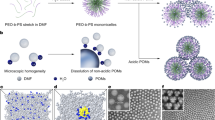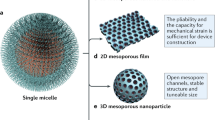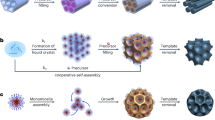Abstract
Surfactant-mediated synthesis methods have attracted much interest for the production of inorganic mesoporous materials, which can, on removal of the surfactant template, incorporate polymeric, organic, inorganic and organometallic ‘guests’ in their pores1,2. These materials—initially made of silica3,4,5, but now also available in the form of other oxides6,7,8,9, sulphides10,11, phosphates12 and metals13—could find application in fields ranging from catalysis, adsorption and sensing technology to nanoelectronics. The extension of surfactant-mediated synthesis to produce inorganic–organic hybrid material (that is, materials that contain organic groups as an integral part of their framework structure) promises access to an even wider range of application possibilities. Such hybrid materials have been produced in the form of amorphous silicates (xerogels) that indeed display unique properties different to those of the individual components14,15,16,17,18,19,20, but their random networks with broad pore-size distributions severely limit the shape and size selectivity of these materials. Mesoporous hybrid materials with periodic frameworks have been synthesized, but the organic groups are all terminally bonded to the pore surface, rather than incorporated into the pore walls21,22,23,24,25,26. Here we describe a periodic mesoporous organosilica containing bridge-bonded ethene groups directly integrated into the silica framework. We are able to solvent-extract and ion-exchange the surfactant templates to create a stable and periodic mesoporous ethenesilica with high surface area and ethene groups that are readily accessible for chemical reaction. Recent syntheses of similar periodic mesoporous organosilicas27,28 and the ability to incorporate a variety of bridging organic and organometallic species raise the prospect of being able to fuse organic synthesis and inorganic materials chemistry to generate new materials with interesting chemical, mechanical electronic, optical and magnetic properties.
This is a preview of subscription content, access via your institution
Access options
Subscribe to this journal
Receive 51 print issues and online access
$199.00 per year
only $3.90 per issue
Buy this article
- Purchase on Springer Link
- Instant access to full article PDF
Prices may be subject to local taxes which are calculated during checkout




Similar content being viewed by others
References
Moller,K. & Bein,T. Inclusion chemistry in periodic mesoporous hosts. Chem. Mater. 10, 2950–2963 (1998).
Ozin,G. A., Chomski,E., Khushalani,D. & MacLachlan,M. J. Mesochemistry. Curr. Opin. Colloid Interface Sci. 3, 181–193 (1998).
Kresge,C. T., Leonowicz,M., Roth,W. J., Vartuli,J. C. & Beck,J. C. Ordered mesoporous molecular sieves synthesized by a liquid-crystal template mechanism. Nature 359, 710–712 (1992).
Beck,J. S. et al. A new family of mesoporous molecular sieves prepared with liquid crystal templates. J. Am. Chem. Soc. 114, 10834–10843 (1992).
Attard,G. S., Glyde,J. C. & Goltner,C. G. Liquid-crystalline phases as templates for the synthesis of mesoporous silica. Nature 378, 366–368 (1995).
Tian,Z.-R. et al. Manganese oxide mesoporous structures: mixed-valent semiconducting catalysts. Science 276, 926–930 (1997).
Bagshaw,S. A. & Pinnavaia,T. J. Mesoporous alumina molecular sieves. Angew. Chem. Int. Edn Engl. 35, 1102–1105 (1996).
Antonelli,D. M. & Ying,J. Y. Synthesis of a stable hexagonally packed mesoporous niobium oxide molecular sieve through a novel ligand-assisted templating mechanism. Angew. Chem. Int. Edn Eng. 35, 426–430 (1996).
Hue,Q. S. et al. Generalized synthesis of periodic surfactant/inorganic composite materials. Nature 368, 317–321 (1994).
Braun,P. V., Osenar,P. & Stupp,S. I. Semiconducting superlattices templated by molecular assemblies. Nature 380, 325–328 (1996).
MacLachlan,M. J., Coombs,N. & Ozin,G. A. Non-aqueous supramolecular assembly of mesostructured metal germanium sulphides from [Ge4S10]4- clusters. Nature 397, 681–684 (1999).
Ciesla,U., Schacht,S., Stucky,G. D., Unger,K. K. & Scüth,F. Formation of a porous zirconium oxophosphate with a high surface area by a surfactant-assisted synthesis. Angew. Chem. Int. Edn Engl. 35, 541–543 (1996).
Attard,G. S., Göltner,C. G., Corker,J. M., Henke,S. & Templer,R. H. Liquid-crystal templates for nanostructured metals. Angew. Chem. Int. Edn Engl. 36, 1315–1317 (1997).
Dagani,R. Nanocomposites. Chem. Eng. News 77(23), 25–37 (1999).
Schubert,U., Hüsing,N. & Lorenz,A. Hybrid inorganic-organic materials by sol-gel processing of organofunctional metal alkoxides. Chem. Mater. 7, 2010–2027 (1995).
Corriu,R. J. P. & Leclercq,D. Recent developments of molecular chemistry for sol-gel processes. Angew. Chem. Int. Edn Engl. 35, 1420–1436 (1996).
Cerveau,G. & Corriu,R. J. P. Some recent developments of polysilsesquioxanes chemistry for materials science. Coord. Chem. Rev. 180, 1051–1071 (1998).
Shea,K. J., Loy,D. A. & Webster,O. Arylsilsesquioxane gels and related materials. New hybrids of organic and inorganic networks. J. Am. Chem. Soc. 114, 6700–6710 (1992).
Loy,D. A. & Shea,K. J. Bridged polysilsequioxanes. Highly porous hybrid organic-inorganic materials. Chem. Rev. 95, 1431–1442 (1995).
Sellinger,A. et al. Continuous self-assembly of organic-inorganic nanocomposite coatings that mimic nacre. Nature 394, 256–260 (1998).
Lim,M. H., Blanford,C. F. & Stein,A. Synthesis and characterization of a reactive vinyl-functionalized MCM-41: probing the internal pore structure by a bromination reaction. J. Am. Chem. Soc. 119, 4090–4091 (1997).
Fowler,C. E., Lebeau,B. & Mann,S. Covalent coupling of an organic chromophore into functionalized MCM-41 mesophases by template-directed co-condensation. Chem. Commun. 1825–1826 (1998).
Burkett,S. L., Sim,s, S. D. & Mann,S. Synthesis of hybrid inorganic-organic mesoporous silica by co-condensation of siloxane and organosiloxane precursors. Chem. Commun. 1367–1368 (1996).
Mercier,L. & Pinnavaia,T. J. Access in mesoporous materials: advantages of a uniform pore structure in the design of a heavy metal ion adsorbent for environmental remediation. Adv. Mater. 9, 500–503 (1997).
Feng,X. et al. Functionalized monolayers on ordered mesoporous supports. Science 276, 923–926 (1997).
Van Rhijn,W. M., De Vos,D. E., Sels,B. F., Bossaert,W. D. & Jacobs,P. A. Sulfonic acid functionalised ordered mesoporous materials as catalysts for condensation and esterification reactions. Chem. Commun. 317–318 (1998).
Inagaki,S., Guan,S., Fukushima,Y., Ohsuna,T. & Terasaki,O. Novel mesoporous materials with a uniform distribution of organic groups and inorganic oxide in their frameworks. J. Am. Chem. Soc. 121, 9611–9614 (1999).
Melde,B. J., Holland,B. T., Blanford,C. F. & Stein,A. Mesoporous sieves with unified hybrid inorganic/organic frameworks. Chem. Mater. 11, 3302–3308 (1999).
Marler,B., Oberhagemann,U., Vortmann,S. & Gies,H. Influence of the sorbate type on the XRD peak intensities of loaded MCM-41. Micropor. Mater. 6, 375–383 (1996).
Chevalier,P., Corriu,R. J. P., Delord,P., Moreau,J. J. E. & Chiman,M. W. Design of porous silica from hybrid organic-inorganic precursors. New J. Chem. 22, 423–433 (1998).
Boury,B. et al. M. W. Hybrid inorganic–inorganic xerogel access to meso- and microporous silica by thermal and chemical treatment. Chem. Mater. 11, 281–291 (1999).
Acknowledgements
We thank C. Y-Ishii for technical assistance with the synthesis and characterization of a wide range of periodic mesoporous organosilicas. This work was supported by the Natural Sciences and Engineering Research Council (NSERC) of Canada. M.J.M. was supported by an NSERC post-graduate scholarship (1995–99); G.A.O. thanks the Isaac Walton Killam Foundation for a research fellowship (1995–97).
Author information
Authors and Affiliations
Corresponding author
Supplementary information
Supplementary Information
Supplementary Information (PDF 751 kb)
Rights and permissions
About this article
Cite this article
Asefa, T., MacLachlan, M., Coombs, N. et al. Periodic mesoporous organosilicas with organic groups inside the channel walls. Nature 402, 867–871 (1999). https://doi.org/10.1038/47229
Received:
Accepted:
Issue Date:
DOI: https://doi.org/10.1038/47229
This article is cited by
-
A review on extractive fermentation via ion exchange adsorption resins opportunities, challenges, and future prospects
Biomass Conversion and Biorefinery (2023)
-
Nanoarchitectured prototypes of mesoporous silica nanoparticles for innovative biomedical applications
Journal of Nanobiotechnology (2022)
-
Design and characterization of an urea-bridged PMO supporting Cu(II) nanoparticles as highly efficient heterogeneous catalyst for synthesis of tetrazole derivatives
Scientific Reports (2022)
-
Lanthanide–based luminescent hybrid silica materials prepared by sol-gel methodologies: a review
Journal of Sol-Gel Science and Technology (2022)
-
Ethane-bridge periodic mesoporous organosilica materials as a novel fiber coating in headspace solid-phase microextraction of phthalate esters from saliva and PET container samples
Analytical and Bioanalytical Chemistry (2022)
Comments
By submitting a comment you agree to abide by our Terms and Community Guidelines. If you find something abusive or that does not comply with our terms or guidelines please flag it as inappropriate.



